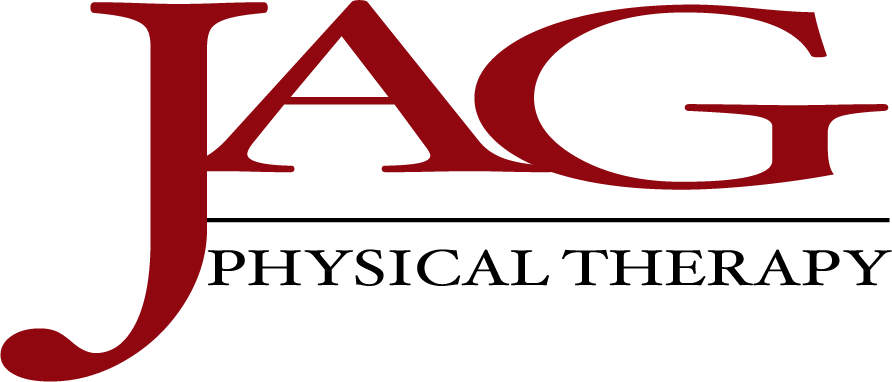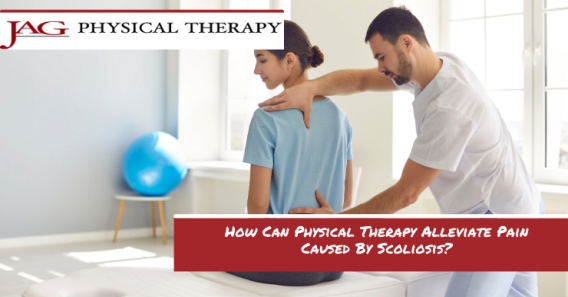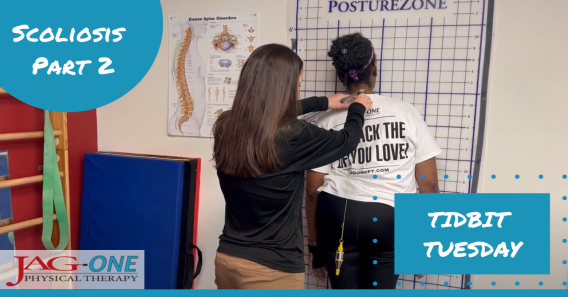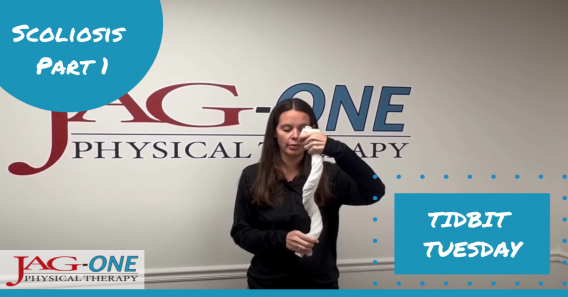If you have Scoliosis, you're not alone. About 2-3% of the US population have the disorder (an estimated 6-9 million people).
Living with scoliosis is a journey, and we're here to guide you through it. The condition can form at any age, for a variety of reasons. There are numerous classifications, so while this is a common condition, your case is likely unique.
JAG PT physical therapists have a deep understanding of scoliosis, its underlying causes, and the many methods available for treatment.
When you come to us for help with scoliosis our goals are to:
- Manage pain and symptoms so that you can live your best life.
- Use the Schroth Method to help improve your condition over time.
- Identify when surgery is necessary, and then help you prepare for and recover from surgery, to achieve the best results for your life.
Our teams will work to understand your individual case and create a personalized treatment plan, helping to alleviate your condition and empowering you to get more joy out of life. Contact us to learn more about how we can help.
What Type of Scoliosis do I Have?
In general terms, scoliosis is a sideways C-shaped or S-shaped curvature in the spine. People with scoliosis may experience pain in their back and throughout the body, and it can lead to serious medical issues if not treated properly.
Three Types (Underlying Causes)
The most common type of scoliosis is idiopathic, meaning its cause is unknown or there are multiple causes. Adolescent idiopathic scoliosis is itself very common, usually forming between ages 10 and 12 years. In these cases, doctors take x-rays of your bones to keep an eye on any curve progression.
Congenital scoliosis encompasses all cases that arise in a child from a spinal defect present at birth.
Neuromuscular scoliosis is caused by a neurological or musculoskeletal malady, like cerebral palsy, muscular dystrophy, spina bifida, or others. Neuromuscular cases typically progress faster than other types of scoliosis.
Three Levels — Mild, Moderate, and Severe
The curvature of the spine occurs in three categories of severity. Each has a different effect on your body function and quality of life and entails different self-care routines and treatment options.
Mild scoliosis ranges from 10-20 degrees, moderate scoliosis from 20-50 degrees, and severe scoliosis from 50 degrees upward.
Mild scoliosis can mostly be treated through self-care, involving certain exercise and stretching routines. Moderate scoliosis may involve physical therapy, chiropractic treatment, or a back brace. Surgery is typically reserved for cases of severe scoliosis.
Parts of the Spine
Thoracic Scoliosis — This is a spinal curve in the upper back and rib cage, often affecting breathing patterns, upper body movements, and activities like walking up stairs or carrying heavy objects.
Lumbar scoliosis — This is a spinal curve in the lower back (lumbar spine) that may cause someone to walk with an uneven gait. It is more common in adults and often causes leg pain.
Thoracolumbar scoliosis — This is a bend in both the lower and upper parts of your spine. It may occur with children in-utero as a secondary effect to neuromuscular maladies such as spina bifida.
What is adult scoliosis?
Scoliosis can be more easily reversed in children, while their bodies are growing. For adults, the best approach is often to manage symptoms or, in severe cases, to pursue surgery.
Adult scoliosis is usually caused by age-related bone degeneration, typically in the lumbar (lower) spine. This is called degenerative scoliosis, “adult-onset” or “late-onset” scoliosis, usually diagnosed in people over 50. You may suppose you have degenerative scoliosis if you feel certain symptoms — like stiffness and dull pain in the lower back or tingling pain that runs down your leg.
How do I check myself or my child for scoliosis?
A self-check for scoliosis is not a substitute for a doctor's diagnosis, but it can be a first step in deciding to seek treatment.
You can check yourself or another by standing straight and looking in the mirror, first from the front and then both sides. Is one hip higher? What about your shoulders? Does one arm or leg seem longer than the other? If you can answer ‘yes’ to one or more of these questions, the next step is to have your doctor provide you with a diagnosis.
Symptoms and Signs
Twenty-three percent of patients with idiopathic scoliosis identify back pain as their first symptom, followed by radiating leg/foot pain. Weakness and numbness can also occur, especially on one side of the body, due to spinal compression and nerve damage.
Some of the common signs and symptoms are:
- A head tilt to one side or another when standing up straight
- The appearance that one shoulder blade sticks out more than the other
- Unevenness of the hips
- The right or left leg appearing longer than the other
- An uneven eye/ear line (one higher than the other due to head tilt)
- Leg numbness and leg pain
Best Practices for Living with Scoliosis
If you have scoliosis, there are many things you can do to minimize its effective
Avoid slouching in your chair or sitting cross-legged. These actions create a more curved spine and make it more difficult to straighten up. If your work requires sitting, alternate equally between crossing one leg over the other and stretching both out in front. Also be sure to get up and walk, ideally every 20 minutes and at least once per hour.
In general, when standing or sitting, always carry your head and shoulders up, and keep your chest high. When lying in bed, stay as flat on your back as possible and place a pillow under your legs to help keep your spine straight.
Do daily stretching and exercises for managing scoliosis at home. While there are some physical restraints that come with the disorder, research shows that exercise helps mitigate them while providing mental health benefits to those who stretch and work out on a regular basis.
A doctor may recommend ibuprofen for everyday pain management in some cases.
Diagnosis
For a doctor to diagnose scoliosis, the curve must be at least 10 degrees. An initial diagnosis is often done through the Adam's Forward Bend Test — a simple screening that can detect scoliosis but not its exact nature or severity. Cases are then confirmed through a physical examination, x-ray, spinal radiograph, CT scan, or MRI.
The degree of curvature is measured through the Cobb Method and diagnosed for severity. Your doctor may also perform a neurological exam to check for any related nerve issues or weakness on one side of the body. After a scoliosis diagnosis, the doctor may refer you to an orthopedic specialist, such as a JAG PT orthopedic physical therapist, for further advice.
Scoliosis is a progressive disorder and difficult to reverse, but there are effective treatments, such as the Schroth Method. Choosing the right treatment for your individual needs will make a big difference in your quality of life.
The Schroth Method
The Schroth approach to Physical Therapy is an expert treatment method with decades of experience behind its development. While other types of scoliosis care typically manage symptoms, the Schroth Method (applied over time) is one of the only ways to correct a spinal curve without surgery.
Learn more about JAG PT’s approach to the Schroth Method.
Understanding When to Consider Surgery
We know that surgery is often a last resort, and we aim to improve your condition without it. Yet there are times when scoliosis patients can benefit from surgery, so we'll monitor your condition and advise you if that's case.
Structural and Nonstructural Curves
With a nonstructural curve, the spine is structurally normal, but other factors cause it to bend. In these cases, physical therapy may help gradually straighten the curve or stop it from getting worse.
With a structural curve, the spine itself is abnormally formed, and while physical therapy may alleviate symptoms, surgery is usually the only way to reverse the curve.
Spinal Fusion Surgery
A spinal fusion is a procedure where a surgeon repairs a spinal curve by joining two or more vertebrae with metal plates, rods, and screws. This can relieve pressure on discs or nerves and create more space between vertebrae, which helps alleviate spinal pain and compression. An anterior lumbar interbody fusion (ALIF) is a specific type of spinal fusion that involves removing part of one vertebra and inserting bone graft material from elsewhere in the patient's body to stabilize the spine.
If you need surgery, we'll guide you through
If it becomes clear that surgery is your best option for a more fulfilling life, we'll design a personalized physical therapy plan to prepare your body for the procedure. Afterward, we'll continue with exercises to strengthen your body and manage symptoms, to guide you through a holistic recovery.
Get Scoliosis Physical Therapy in NJ, NY & PA with JAG PT
When it comes time to treat your scoliosis, we not only give you expert advice and personalized treatment, we work to understand how your treatment plan aligns with your life goals and values.
To get started, send us a message or contact a JAG Physical Therapy location near you to schedule an appointment.
Our teams are standing by to help you get back the life you love.




